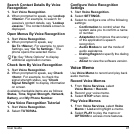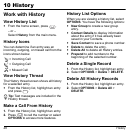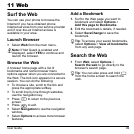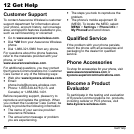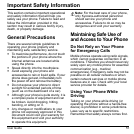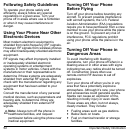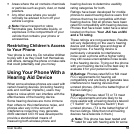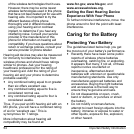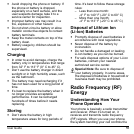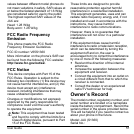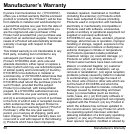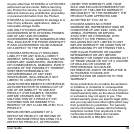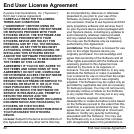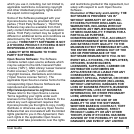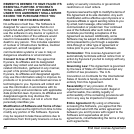
User Guide 55
Avoid dropping the phone or battery. If
the phone or battery is dropped,
especially on a hard surface, and the
user suspects damage, take it to a
service center for inspection.
Improper battery use may result in a
fire, explosion or other hazard.
Do not short-circuit a battery or allow
metallic conductive objects to contact
battery terminals.
Keep the metal contacts on top of the
battery clean.
Battery usage by children should be
supervised.
Charging
In order to avoid damage, charge the
battery only in temperatures that range
from 32° F to 113° F (0° C to 45° C).
Don’t use the battery charger in direct
sunlight or in high humidity areas, such
as the bathroom.
The battery may need recharging if it
has not been used for a long period of
time.
It’s best to replace the battery when it
no longer provides acceptable
performance. It can be recharged
hundreds of times before it needs
replacing.
Storing
Don’t store the battery in high
temperature areas for long periods of
time. It’s best to follow these storage
rules:
– Less than one month:
-4° F to 140° F (-20° C to 60° C)
– More than one month:
-4° F to 113° F (-20° C to 45° C)
Disposal of Lithium Ion
(Li-Ion) Batteries
Promptly dispose of used batteries in
accordance with local regulations.
Never dispose of the battery by
incineration.
Do not handle a damaged or leaking
Li-Ion battery as you can be burned.
For safe disposal options of your Li-Ion
batteries, contact your nearest
authorized service center.
Special Note: Be sure to dispose of
your battery properly. In some areas,
the disposal of batteries in household or
business trash may be prohibited.
Radio Frequency (RF)
Energy
Understanding How Your
Phone Operates
Your phone is basically a radio transmitter
and receiver. When it’s turned on, it
receives and transmits radio frequency
(RF) signals. When you use your phone,
the system handling your call controls the



